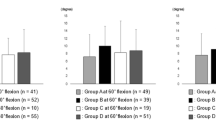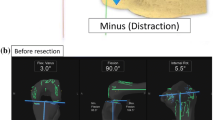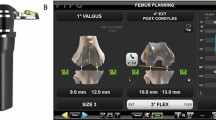Abstract
Purpose
This study aims to make clear the influence of the tibial slope on intra-operative soft tissue balance measurements using a tensor in cruciate-retaining and posterior-stabilized total knee arthroplasty (TKA).
Methods
Forty patients with osteoarthritis of the knee received TKAs (20 cruciate-retaining TKAs and 20 posterior-stabilized TKA). Soft tissue balance was measured using an offset type tensor at 0, 10, 45, 90, 135 degrees of knee flexion. The tibial slopes were measured by post-operative lateral radiograph. The correlation between the tibial slope and values of soft tissue balance were assessed.
Results
Joint component gap at 90° (R = 0.537, p < 0.01) and 135° (R = 0.463, p < 0.05) of flexion and joint component gap change value of 90–0° (R = 0.433, p < 0.05) showed positive correlations with tibial slope in posterior-stabilized TKA. There was no relationship between the tibial slope and the value of soft tissue balances in cruciate-retaining TKA.
Conclusions
In the present study, we confirmed that increasing the tibial slope resulted in a larger flexion gap compared to extension gap in posterior-stabilized TKA. Surgeons should be aware that increasing the tibial slope is one factor responsible for widening the flexion–extension gap difference in posterior-stabilized TKA.
Level of evidence
III.






Similar content being viewed by others
References
Banks SA, Markovich GD, Hodge WA (1997) In vivo kinematics of cruciate-retaining and -substituting knee arthroplasties. J Arthroplast 12(3):297–304
Bellemans J, Banks S, Victor J, Vandenneucker H, Moemans A (2002) Fluoroscopic analysis of the kinematics of deep flexion in total knee arthroplasty. Influence of posterior condylar offset. J Bone Jt Surg Br 84(1):50–53
Bellemans J, Robijns F, Duerinckx J, Banks S, Vandenneucker H (2005) The influence of tibial slope on maximal flexion after total knee arthroplasty. Knee Surg Sports Traumatol Arthrosc 13(3):193–196
Callaghan JJ, O’Rourke MR, Goetz DD, Schmalzried TP, Campbell PA, Johnston RC (2002) Tibial post impingement in posterior-stabilized total knee arthroplasty. Clin Orthop Relat Res 404:83–88
Catani F, Fantozzi S, Ensini A, Leardini A, Moschella D, Giannini S (2006) Influence of tibial component posterior slope on in vivo knee kinematics in fixed-bearing total knee arthroplasty. J Orthop Res 24(4):581–587
Dennis DA, Komistek RD, Colwell CE Jr, Ranawat CS, Scott RD, Thornhill TS, Lapp MA (1998) In vivo anteroposterior femorotibial translation of total knee arthroplasty: a multicenter analysis. Clin Orthop Relat Res 356:47–57
Devers BN, Conditt MA, Jamieson ML, Driscoll MD, Noble PC, Parsley BS (2011) Does greater knee flexion increase patient function and satisfaction after total knee arthroplasty? J Arthroplast 26(2):178–186
Fujimoto E, Sasashige Y, Masuda Y, Hisatome T, Eguchi A, Masuda T, Sawa M, Nagata Y (2012) Significant effect of the posterior tibial slope and medial/lateral ligament balance on knee flexion in total knee arthroplasty. Knee Surg Sports Traumatol Arthrosc. doi:10.1007/s00167-012-2059-6
In Y, Kim JM, Woo YK, Choi NY, Sohn JM, Koh HS (2009) Factors affecting flexion gap tightness in cruciate-retaining total knee arthroplasty. J Arthroplast 24(2):317–321
Jojima H, Whiteside LA, Ogata K (2004) Effect of tibial slope or posterior cruciate ligament release on knee kinematics. Clin Orthop Relat Res 426:194–198
Kansara D, Markel DC (2006) The effect of posterior tibial slope on range of motion after total knee arthroplasty. J Arthroplast 21(6):809–813
Li G, Papannagari R, Most E, Park SE, Johnson T, Tanamal L, Rubash HE (2005) Anterior tibial post impingement in a posterior stabilized total knee arthroplasty. J Orthop Res 23(3):536–541
Lombardi AV Jr, Berend KR, Aziz-Jacobo J, Davis MB (2008) Balancing the flexion gap: relationship between tibial slope and posterior cruciate ligament release and correlation with range of motion. J Bone Jt Surg Am 90(Suppl 4):121–132
Malviya A, Lingard EA, Weir DJ, Deehan DJ (2009) Predicting range of movement after knee replacement: the importance of posterior condylar offset and tibial slope. Knee Surg Sports Traumatol Arthrosc 17(5):491–498
Massin P, Gournay A (2006) Optimization of the posterior condylar offset, tibial slope, and condylar roll-back in total knee arthroplasty. J Arthroplast 21(6):889–896
Matsuda S, Kawahara S, Okazaki K, Tashiro Y, Iwamoto Y (2013) Postoperative alignment and ROM affect patient satisfaction after TKA. Clin Orthop Relat Res 471:127–133
Matsumoto T, Kuroda R, Kubo S, Muratsu H, Mizuno K, Kurosaka M (2009) The intra-operative joint gap in cruciate-retaining compared with posterior-stabilised total knee replacement. J Bone Jt Surg Br 91(4):475–480
Matsumoto T, Mizuno K, Muratsu H, Tsumura N, Fukase N, Kubo S, Yoshiya S, Kurosaka M, Kuroda R (2007) Influence of intra-operative joint gap on post-operative flexion angle in osteoarthritis patients undergoing posterior-stabilized total knee arthroplasty. Knee Surg Sports Traumatol Arthrosc 15(8):1013–1018
Matsumoto T, Muratsu H, Kubo S, Matsushita T, Kurosaka M, Kuroda R (2011) Soft tissue tension in cruciate-retaining and posterior-stabilized total knee arthroplasty. J Arthroplast 26(5):788–795
Matsumoto T, Muratsu H, Tsumura N, Mizuno K, Kuroda R, Yoshiya S, Kurosaka M (2006) Joint gap kinematics in posterior-stabilized total knee arthroplasty measured by a new tensor with the navigation system. J Biomech Eng 128(6):867–871
Matsumoto T, Muratsu H, Tsumura N, Mizuno K, Kurosaka M, Kuroda R (2009) Soft tissue balance measurement in posterior-stabilized total knee arthroplasty with a navigation system. J Arthroplast 24(3):358–364
Matsumoto T, Tsumura N, Kubo S, Shiba R, Kurosaka M, Yoshiya S (2005) Influence of hip position on knee flexion angle in patients undergoing total knee arthroplasty. J Arthroplast 20(5):669–673
Matziolis G, Mehlhorn S, Schattat N, Diederichs G, Hube R, Perka C, Matziolis D (2012) How much of the PCL is really preserved during the tibial cut? Knee Surg Sports Traumatol Arthrosc 20(6):1083–1086
Mizu-uchi H, Colwell CW Jr, Matsuda S, Flores-Hernandez C, Iwamoto Y, D’Lima DD (2011) Effect of total knee arthroplasty implant position on flexion angle before implant-bone impingement. J Arthroplast 26(5):721–727
Muratsu H, Matsumoto T, Kubo S, Maruo A, Miya H, Kurosaka M, Kuroda R (2010) Femoral component placement changes soft tissue balance in posterior-stabilized total knee arthroplasty. Clin Biomech (Bristol, Avon) 25(9):926–930
Nozaki H, Banks SA, Suguro T, Hodge WA (2002) Observations of femoral rollback in cruciate-retaining knee arthroplasty. Clin Orthop Relat Res 404:308–314
Oka S, Muratsu H, Matsumoto T, Kubo S, Maruo A, Miya H, Kuroda R, Kurosaka M (2012) The influence of patellar position on soft tissue balance in minimal incision total knee arthroplasty. Knee Surg Sports Traumatol Arthrosc 20(6):1064–1068
Ostermeier S, Hurschler C, Windhagen H, Stukenborg-Colsman C (2006) In vitro investigation of the influence of tibial slope on quadriceps extension force after total knee arthroplasty. Knee Surg Sports Traumatol Arthrosc 14(10):934–939
Ostermeier S, Schlomach C, Hurschler C, Windhagen H, Stukenborg-Colsman C (2006) Dynamic in vitro measurement of posterior cruciate ligament load and tibiofemoral stress after TKA in dependence on tibiofemoral slope. Clin Biomech (Bristol, Avon) 21(5):525–532
Padua R, Ceccarelli E, Bondi R, Campi A, Padua L (2007) Range of motion correlates with patient perception of TKA outcome. Clin Orthop Relat Res 460:174–177
Ritter MA (2006) High-flexion knee designs: more hype than hope? In the affirmative. J Arthroplast 21(4 Suppl 1):40–41
Sasaki H, Kubo S, Matsumoto T, Muratsu H, Matsushita T, Ishida K, Takayama K, Oka S, Kurosaka M, Kuroda R (2012) The influence of patella height on intra-operative soft tissue balance in posterior-stabilized total knee arthroplasty. Knee Surg Sports Traumatol Arthrosc 20(11):2191–2196
Schirm AC, Jeffcote BO, Nicholls RL, Jakob H, Kuster MS (2011) Sensitivity of knee soft-tissues to surgical technique in total knee arthroplasty. Knee 18(3):180–184
Schurman DJ, Rojer DE (2005) Total knee arthroplasty: range of motion across five systems. Clin Orthop Relat Res 430:132–137
Schwab JH, Haidukewych GJ, Hanssen AD, Jacofsky DJ, Pagnano MW (2005) Flexion instability without dislocation after posterior stabilized total knees. Clin Orthop Relat Res 440:96–100
Sierra RJ, Berry DJ (2008) Surgical technique differences between posterior-substituting and cruciate-retaining total knee arthroplasty. J Arthroplast 23(7 Suppl):20–23
Singerman R, Dean JC, Pagan HD, Goldberg VM (1996) Decreased posterior tibial slope increases strain in the posterior cruciate ligament following total knee arthroplasty. J Arthroplast 11(1):99–103
Stiehl JB, Dennis DA, Komistek RD, Keblish PA (2000) In vivo kinematic comparison of posterior cruciate ligament retention or sacrifice with a mobile bearing total knee arthroplasty. Am J Knee Surg 13(1):13–18
Takayama K, Matsumoto T, Kubo S, Muratsu H, Ishida K, Matsushita T, Kurosaka M, Kuroda R (2012) Influence of intra-operative joint gaps on post-operative flexion angle in posterior cruciate-retaining total knee arthroplasty. Knee Surg Sports Traumatol Arthrosc 20(3):532–537
Tanaka K, Muratsu H, Mizuno K, Kuroda R, Yoshiya S, Kurosaka M (2007) Soft tissue balance measurement in anterior cruciate ligament-resected knee joint: cadaveric study as a model for cruciate-retaining total knee arthroplasty. J Orthop Sci 12(2):149–153
Whiteside LA, Amador DD (1988) The effect of posterior tibial slope on knee stability after Ortholoc total knee arthroplasty. J Arthroplast 3(Suppl):S51–S57
Author information
Authors and Affiliations
Corresponding author
Rights and permissions
About this article
Cite this article
Oka, S., Matsumoto, T., Muratsu, H. et al. The influence of the tibial slope on intra-operative soft tissue balance in cruciate-retaining and posterior-stabilized total knee arthroplasty. Knee Surg Sports Traumatol Arthrosc 22, 1812–1818 (2014). https://doi.org/10.1007/s00167-013-2535-7
Received:
Accepted:
Published:
Issue Date:
DOI: https://doi.org/10.1007/s00167-013-2535-7




